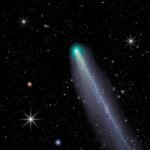An asteroid once considered the greatest known threat to Earth has resurfaced in scientific discussions following updated forecasts, which show a slightly increased possibility of it striking the moon in 2032.
The object, named 2024 YR4, now has a 4.3% chance of colliding with the lunar surface on 22 December 2032, according to new data shared by NASA. This is a modest rise from the earlier estimate of 3.8%. The US space agency noted that such changes are typical, as improved observations continue to refine predictions of near-Earth object paths.
NASA clarified that even if 2024 YR4 were to hit the moon, it would not disturb its orbit or pose any danger to Earth.
First detected in December 2024, the asteroid is estimated to measure between 53 and 67 metres — similar in size to a ten-storey building. It reappeared briefly in May 2025, when the James Webb Space Telescope captured fresh data using its Near-Infrared Camera. A team led by Andy Rivkin from Johns Hopkins Applied Physics Laboratory used this data to enhance tracking models, reportedly increasing prediction accuracy by nearly 20%.
Read More: Role of space technology in national development
In early 2025, there was rising concern as the asteroid’s chance of hitting Earth peaked at 3.1%, the highest recorded for a sizeable space rock. However, by February, further tracking helped scientists rule out any risk to Earth, lowering the probability to 0.004%. NASA declared the planet safe, assuring the asteroid would fly past harmlessly.
With focus now shifting to a potential lunar impact, experts have reiterated that such an event is harmless. Dr Pawan Kumar, an astrophysicist formerly with the Indian Institute of Astrophysics, said the moon remains unaffected by such incidents and that any resulting debris would likely burn up in Earth’s atmosphere.






